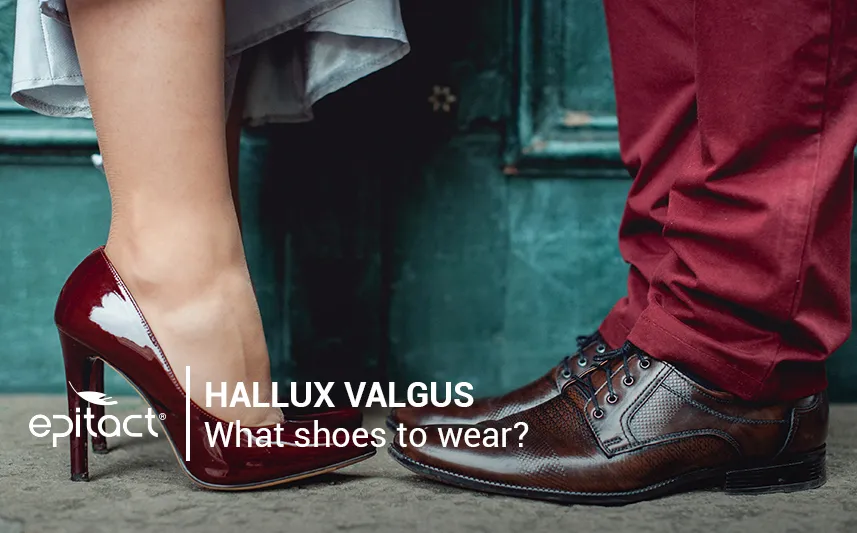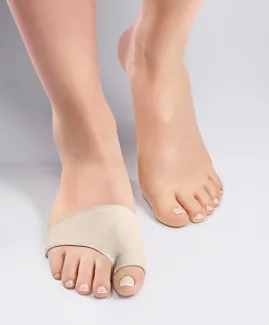
Do you know that wearing poorly-fitted shoes is one of the major risk factors for developing bunions? In addition, the bony bump is very likely to rub and press the shoe, causing intense pain while walking. Find in this article some tips to choose the best shoes for bunions and the types of bunion shoes you should avoid.
Link between bunion and shoes
A bunion, also called hallux valgus, is a deviation of the big toe towards the other toes. It appears progressively and changes the shape of the forefoot. The more the big toe drifts inwards, the more the bunion juts out at the base of the big toe. As a consequence, the shoe creates friction and pressure on the bunion which becomes irritated, red and very painful.
This is why you should wear shoes for bunions that fit well your shape. If the shoe is too tight or pointy for example, it keeps your big toe deviated and contributes to increasing the deformity.
How to choose the proper bunion shoes?
What are the best shoes for bunions according to the stage of your foot deformity or of your activity? Do other solutions exist to prevent bunion pain?
Give your toes some space
In order to limit the progression of your bunions, enjoy the summer season to provide your feet some rest with minimalist models of shoes! Open shoes, sandals and flip-flops will give your feet more room and avoid rubbing and pressure with the footwear. Prefer shoes with a thong between the first and second toe for a ‘spacer effect’. On the contrary, some shoes make bunions worse like those with a thong that squeezes the first phalanx: it would increase its deviation.
At home, remove your shoes as much as possible to constrain your toes as little as possible.
Choose shoes for bunions that are adapted to your activity
Who hasn't fallen for a stylish and super trendy pair of shoes? By wearing them occasionally, your feet aren't threatened.
Just think about changing the model of shoes regularly in order to vary the supports: wearing the same pair several days in a row increases the deformity of the shoe and of the sole. Indeed, the humidity in the shoe resulting from natural sweating of the feet can’t dry from one day to the next.
Finally, choose bunion shoes that are adapted to your activity: sport, work, ceremonies...
The best shoes for bunions have a moderate heel height
You might think it is a question of common sense! High heels push the foot towards the front of the shoe, and so put pressure on the joint of the first metatarsal bone and consequently, on the bunion. In case of wedge heels, the knees are the one suffering the consequences. Definitely to be banned...
Wear silicone protections to avoid rubbing and pressure in the shoe
While wearing dress shoes, you can limit rubbing by putting on a silicone bunion shield on the painful area. The EPITACT® bunion protector* was designed to ease pain immediately by protecting from pressures and frictions on the bony bump. Thanks to its thinness, it is discreet in the shoe and very comfortable. Also, this reusable bunion protector is washable.
EPITACT® has also created a flexible bunion corrector* that realigns your big toe when you walk and relieve your pain. It is recommended if you have a mild bunion and your big toe can still move laterally.
Flat bunion shoes are not a miracle cure either
If you have a bunion, shoes with a flat sole should be avoided. Ballerinas or classic tennis shoes, appearing so comfortable can have bad consequences, in particular the inflammation of the tissue located under the foot (plantar fasciitis). Indeed, the foot arch is not supported and a small heel is needed to decrease the stress on this tissue while walking.
If you want walking or dancing all night, opt for shoes with a heel height from 3 to 4 cm. Your whole body will be grateful to you.
Choosing a form adapted to your foot
To choose the best shoes for your bunions, the ideal is to go shopping for shoes at the end of the day when the feet tend to be swollen. While trying a pair of shoes in the store (and I repeat ‘a pair’ because each foot is different), check that they don’t cause pressure points on your foot. The space at the tip of the shoe must be large enough.
So, avoid pointy shoes even if the dictates of fashion encourage you to consume. When the seller tells you: ‘The shoes will stretch’, don’t believe it! You must feel comfortable immediately during the fitting.
The best shoes for bunions are made of flexible materials
To feel comfortable in your shoes, they have to be adapted to your foot shape. To do so, opt for bunion shoes with flexible materials. Some fine leathers such as the lamb or woven leathers are frequently part of the best shoes for bunions.
The fabric is also an interesting alternative. Indeed, you can forget plastic shoes that can be recognized thanks to the diamond symbol. This type of shoes is not sufficiently flexible to be comfortable enough when you wear them on a daily basis. In addition, they may favour maceration and therefore the development of mycoses.
Having bunion shoes made by a healthcare professional
Hallux valgus is a permanent deformity so it is crucial to do whatever you can to stop it. On the one hand, you can gather information about all the risk factors and causes of bunions and try to identify which ones stick to your situation. This is the first step in the prevention of the bunion symptoms. On the other hand, you can consult your general practitioner who can prescribe you the best treatment.
If the deformity is at an advanced stage, surgery is the only definitive solution. If your big toe still moves laterally, your GP can refer you to a podiatrist or an orthopaedist.
Indeed, one way of correcting the deviation is to have custom-made orthopaedic shoes or insoles. They allow the foot to recover proper supports and them limit the risk of suffering the consequences of bunions (e.g.: hammer toes, painful corns and calluses…).
Is wearing the best shoes for bunions sufficient to prevent bunions from developing?
Unfortunately, no. Indeed, poorly-fitted shoes are one risk factor of bunions. There are also genetic factors (heredity), anatomical factors (e.g.: flat feet) or physiological factors (e.g.: overweight). Then some people develop bunions even though they are not used to wearing inappropriate shoes.
Wearing the best shoes for bunions just helps to reduce the risk of developing a bunion.
To sum up, people with bunions should wear comfortable bunion shoes. Opt for footwear with a wide toe box a wide toe shoes made of flexible and soft leather with a low heel from 3 to 4 cm for women and 2 cm for men. As a complement, feel free to preserve the joint flexibility of the bunion with some regular exercises to avoid worsening of the deformity. Now that you know what are the best shoes for bunions, learn about the other risk factors of such deformity in order to limit its painful symptoms.

*These products are class I medical devices that bear the CE marking under this regulation. Carefully read the instructions before use. Manufacturer: Millet Innovation. 07/2021
 Pharmacie
Pharmacie
